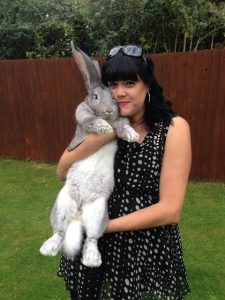Introduction
Quick Navigation
Giant rabbits can formulate beautiful pets. Their more significant than life personalities and vast stature make them enjoyable to acquire. Nonetheless, they arrive with their pack of outstanding ordinances and potential dilemmas, so it is crucial to confirm you can satisfy these needs before bringing about the obligation.
Check here for more details
Accommodation
As you would foresee, the sheer altitude that these rabbits can attain implies that they require much bigger accommodation than lesser rabbits.
All rabbits should be conserved in neutered pairs or bigger groups, and giant rabbits are no exemption. Pet shop hutches are hard, if ever, big sufficiently to acclimate two giant rabbits or just a giant rabbit and a smaller species. Giant rabbits may be above 4ft when outstretching or strutting on their hind legs, and as an absolute minimum, they should be eligible to put up with at least three straight hops in any path at a time potentially 12ft in full. Hence, it is adequate to acclimate giant rabbits in a big cottage, aviary or cottage rabbit alliance. Sheds can effortlessly be renovated and an outdoor run attached, and aviaries appear available created with an indoor and outdoor compartment. This gives the rabbits abundance of room. Tunnels, toys and shelves to jump onto can all be put in into such habitat to provide more fun.
All of this succeeds at a cost, and as an absolute minimum, you can predict to expend more than £250 for housing adequate for giant rabbits. This needs to be contemplated carefully before amassing giant rabbits.
As with all rabbits, giants specifically need a day-to-day workout instead in a comfortable and protected garden, free from possible predators, departure routes and harmful plants. Will you be able to procure this or a large more than 20ft square of the area in which they can work out, have fun, graze and forage?
See here also for further reference
Handling
The preponderance of rabbits does not like being dealt with, and giant breeds are no exception. Their vast size renders them uneasy and constantly hard to control safely and expertly. They can impose nasty cuts and strong kicks in a venture to flee from inappropriate treatment. This cannot just wound the owner but also result in fatal spinal/hind limb cracks to the rabbit. This should be handled when crucial, i.e., health survey, inspecting and cleaning back edge, claw clipping and a lot more. It should also be dealt with by the possessor sitting on the floor. The spine must be aided at all moments.
Feeding
Contrary to common assumption, giant rabbits do not need much in the way of combined food. Inexperienced, maturing rabbits need additional concentrated food, preferably extruded chunks, to stave off choosy feeding. Still, group giant rabbits only need a tiny bit or just over an eggcup of pellets each daily.
Put more percentages of hay, a big pile of new greens, and fresh, neat water is similarly needed each day, as with every rabbit.
Check here for more details
Giant rabbits do not require any mineral or vitamin additions to their food if they are nourished as above, except mainly stipulated by your vet.
Flystrike
Flystrike can influence any breed of rabbit, but numerous giant rabbits, mainly do, may retain an obvious dewlap which impedes training around the back end. It is vital to strive and protect giant rabbits on the slim side to deter this from happening, and surveying their rear end at least two a times day, employing preventative regulations fly netting, Rear-guard and a lot more. This product can be utilised if your rabbit is at threat of flystrike, approved by your vet, and cleaning when necessary is an absolute must.
Check here for more
Health problems
Heart problems
Heart problems are furthermore observed in giant rabbits. Cardiomyopathy is considered to be vastly more prevalent in large and significant species of rabbit and can be the factor of abrupt death in giant rabbit breeds. Dilated cardiomyopathy, where the heart becomes enlarged and weakened, implying it cannot distribute blood adequately all over the body, is the vastly naturally recognised heart problem in giant rabbits. If detected, early medical administration can be given.
Pododermatitis (sore hocks)
Because of their enormous size, giant rabbits are very inclined to Pododermatitis (sore hocks) due to the tension pertained to the hock. These can come to be expanded if not detected and attended to early, so significantly, thick, soft bedding is utilised and the hock/feet areas tested daily.
Check also for more details
Arthritis and spondylosis
Arthritis and spinal spondylosis appear to be very rampant in giant rabbits as they continue to grow. You may catch a glimpse of the rabbit calming down, walking on their hind limbs, and coming to be urine and faecal contaminated. The situations can always be supervised medically with drug, so it is crucial to carry your rabbit to see your vet as quickly as possible.
features
Coat
A Continental Giant’s fur will be bright, dense, and thick. There will be guard hairs apparent, and the undercoat will be fluffy and plentiful, with a reasonable amount of density.
Check also for more about giant rabbits
You will require to groom your rabbit constantly to protect the coat healthy. Furthermore, large rabbit breeds occasionally have difficulty keeping themselves fit, especially when they become older, so you will have to put up with steps to guarantee your continental giant is ever clean.
Colours
This breed can caption a mixture of colours that comprise light grey, steel grey, fawn, sandy, black, and white.
Conclusion
Giant rabbits can bring about excellent pets. Their more significant than life personalities and vast stature render them interesting to own. Nonetheless, they arrive with their bunch of particular requirements and possibility dilemmas, so it is vital to confirm you can confront these needs before giving rise to the commitment.

